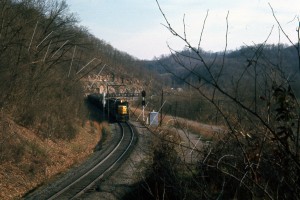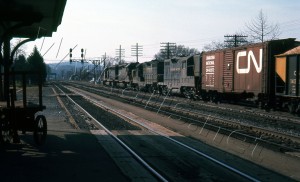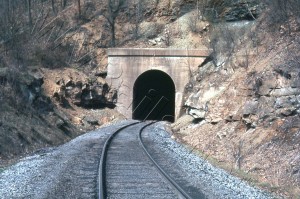Train #3 The Fast Flying Virginian at St Albans on a cool March day in 1967. In just a little over a year This scene will be but just a memory.
Another favorite place of mine to photograph trains was around the St. Albans area. St Albans is located along the Kanawha River approximately 12 miles west of downtown Charleston. It is situated at the point where Coal River flows into the Kanawha. It is one of the few rivers in the United States besides the Kanawha, New and Monongahela that flows north. If you are interested in reading up on the history of St Albans you can go to www.stablanshistory.com and click on the various links.
 Three EMD SD-18s leading a coal train westbound is about to pass the St Albans Depot in March 1967. The train is coming off the Coal River Branch.
Three EMD SD-18s leading a coal train westbound is about to pass the St Albans Depot in March 1967. The train is coming off the Coal River Branch.
In addition to main line of the Chesapeake and Ohio Railway passing through St. Albans, the Coal River Branch joined the C&O main approximately half a mile east of the St Albans depot. The junction afforded loaded coal trains coming from the coal fields the option to head east toward the coal loading piers at Newport News, Va or north toward the Great Lakes.
 Coal Train on the Coal River Branch is heading geographically north toward the C&O main which is about a half mile from this point. The telltales hanging from the support next to the signal warns crew of an approaching low clearance which in this case is St. Albans Tunnel.
Coal Train on the Coal River Branch is heading geographically north toward the C&O main which is about a half mile from this point. The telltales hanging from the support next to the signal warns crew of an approaching low clearance which in this case is St. Albans Tunnel.
The depot at St Albans was the location I enjoyed the most. The depot had a small umbrella shed the length of the building that paralleled the main track. It was a good place to be under during the hot summers to wait on the next train to come by. Besides movements on the mainline, you could catch an occasional coal train coming off the Coal River line heading westbound.
 Caboose of same train about to enter in St Albans Tunnel. The head end of the train should be already on the mainline.
Caboose of same train about to enter in St Albans Tunnel. The head end of the train should be already on the mainline.
The Coal River Branch of the C&O followed its namesake for most of the way south from St Albans. Approximately 15 miles south of town near the community of Alum Creek, the Coal split into the Big Coal and Little Coal rivers. The Coal River Branch followed the Big Coal for another couple of miles below that point to the community of Sproul, where the line splits. From this point there were branches running along Big and Little Coal rivers to coal mines further south.
The Coal River Branch started out as the Coal River and Western around 1901 and later became the Coal River Railroad. The C&O had been built through this area in the early 1870’s to a far as Huntington. As you can see on the map below, the branch took winding route through town. Approximately 20 years later the the junction of the now Coal River Branch was relocated approximately a three tenths of a mile east of the original junction. This was most likely done to keep trains from blocking city streets. The current alignment is all grade separated. A stub of the old junction off the C&O main in town which ran as far as 6th Ave remained for a number of years. It is has now been removed.
 Map of St Albans showing the C&O Main Line running across the upper half of the map from left to right. The Coal River Branch is on the right side of the map running north and south where St Albans tunnel is noted. The line in red is the original Coal River Branch that the C&O purchased from the Coal River Railroad around 1906.
Map of St Albans showing the C&O Main Line running across the upper half of the map from left to right. The Coal River Branch is on the right side of the map running north and south where St Albans tunnel is noted. The line in red is the original Coal River Branch that the C&O purchased from the Coal River Railroad around 1906.
 View looking north toward St Albans Tunnel. The track to the left was the original Coal River Branch that followed Pennsylvania Ave into town. Only a couple hundred feet remained back in the 1960’s. The track may have been left to store Maintenance of Way equipment or used to set off bad order cars. Today this track is gone.
View looking north toward St Albans Tunnel. The track to the left was the original Coal River Branch that followed Pennsylvania Ave into town. Only a couple hundred feet remained back in the 1960’s. The track may have been left to store Maintenance of Way equipment or used to set off bad order cars. Today this track is gone.
Much has changed since the formation of CSX in 1980 but in the last couple of years, beginning around 2009, the mainline of the former C&O has taken on a new look. Gone are the old C&O style signals. They have been replaced by newer type or as I have heard some say Seaboard style signals. Also the communication lines are practically gone now. The old depot is still there thanks to the efforts of those who have worked hard to keep the memories of the C&O alive for years to come. If you are in the area I strongly suggest stopping by for a visit.
 Westbound freight on the westward siding. In the distance you can see the wayside signal with a medium clear signal (red over green) which indicates the engineer has authority to go on the #1 main track. Way in the distance just to the right of the big evergreen trees is the bridge over Coal River.
Westbound freight on the westward siding. In the distance you can see the wayside signal with a medium clear signal (red over green) which indicates the engineer has authority to go on the #1 main track. Way in the distance just to the right of the big evergreen trees is the bridge over Coal River.
 View of St Albans Cabin. The operator controlled train movements on the Coal River line. The building was located near the west leg of the wye.
View of St Albans Cabin. The operator controlled train movements on the Coal River line. The building was located near the west leg of the wye.
 Another view of the south portal of St Albans Tunnel. The north end was inaccessible because it was in a deep narrow cut that would put a person in danger if a train came. Even though the tunnel was a few hundred feet long the curvature prevented a person from seeing the other end. Besides you would be trespassing on railroad property.
Another view of the south portal of St Albans Tunnel. The north end was inaccessible because it was in a deep narrow cut that would put a person in danger if a train came. Even though the tunnel was a few hundred feet long the curvature prevented a person from seeing the other end. Besides you would be trespassing on railroad property.
 Westbound coal drag passing by the St Albans Depot with three SD-18s on the head end. The units were originally delivered to the C&O in the 1800 series. They were renumbered a few years later to the 7300 series in anticipation of a merger with the Norfolk and Western Railway which did not occur because of the bankruptcy of Penn Central and other northeast railroads.
Westbound coal drag passing by the St Albans Depot with three SD-18s on the head end. The units were originally delivered to the C&O in the 1800 series. They were renumbered a few years later to the 7300 series in anticipation of a merger with the Norfolk and Western Railway which did not occur because of the bankruptcy of Penn Central and other northeast railroads.
 View of a part of the St Albans Yard east of the depot looking east. Westbound freight is on the Westward Siding. This is the same train shown passing the depot a few pictures above. In the background is the junction of the Coal River Branch just beyond the sand tower.
View of a part of the St Albans Yard east of the depot looking east. Westbound freight is on the Westward Siding. This is the same train shown passing the depot a few pictures above. In the background is the junction of the Coal River Branch just beyond the sand tower.


Recent Comments